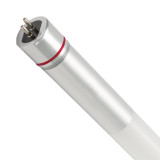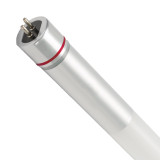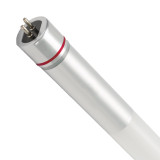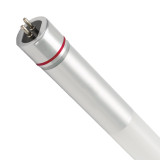T5 LED Tube Lights
-
 F6T5 (9 in.) - LED Replacements
F6T5 (9 in.) - LED Replacements
-
 F8T5 (1 ft.) - LED Replacements
F8T5 (1 ft.) - LED Replacements
-
 F13T5 (21 in.) - LED Replacements
F13T5 (21 in.) - LED Replacements
-
 F24T5 (2 ft.) - LED Replacements
F24T5 (2 ft.) - LED Replacements
-
 F39T5 (3 ft.) - LED Replacements
F39T5 (3 ft.) - LED Replacements
-
 F54T5 (4 ft.) - LED Replacements
F54T5 (4 ft.) - LED Replacements
T5 LED Tube Lights
What is the length of my fluorescent tube light?
Tube lights come in standard lengths for the most part such as 2 ft, 3 ft, and 4 ft. Typically, the longer the tube the more power it consumes (higher wattage rating). However, this is not always the case. Some specialty lights out there do exist that have the same wattage rating but differ drastically on the length or vice versa. The lighting industry standard measures bulbs to their ‘nominal’ length that is slightly longer than the bulb itself. This is for simplicity and because the summation of the lamp length and the width of the two lamp holders makes nears the nominal length. Always measure your bulb and check with the specifications or a sales associate to confirm if the LED tube will work in place of your fluorescent.
Operation Types – Ballast or No Ballast
Fluorescent lights are controlled by electronic and sometimes magnetic transformers called lighting ballasts. These ballasts regulate the incoming electricity to power the light. Due to their ubiquitous presence in lighting fixtures, lighting manufacturers wished to make conversion to LED tube lights as seamless as possible. Thus, LED tubes come in four types of operation modes to give the customer the choice if they want to re-wire and remove existing ballasts or keep them.
UL Type A – Plug and Play
Type A lights are called plug and play because they are compatible with existing electronic fluorescent lighting ballasts. Turn off the power, remove the fluorescent tube, plug in the LED tube, and turn the power back on. It is the same as replacing a bad fluorescent with a new one! Just make sure the ballast inside the fixture is a model that is listed on the manufacturer’s ballast compatible list. If the ballast is not on the list the LED lamp might still work, however since it has not been tested and approved by the tube manufacturer, the warranty on the LED is voided.
UL Type B – Ballast Bypass
Type B lights work directly off line voltage – typically 120V to 277V – because they have an internal LED driver that performs the role of the ballast but without all the extra wires! With Type B lamps you will need to do some re-wiring of the fixture. With bypass lamps there is an additional layer of complexity involving the way the LED tube receives power. They could be single-ended or double-ending meaning they may or might not work with existing lamp holders. It is best to carefully read the product pages for LED tubes and to confirm with the hardware in your own fixture before making a purchase.
UL Type C – External Driver
Type C lights are like Type A lamps but instead of working with an external electronic fluorescent ballast to handle their power delivery they use an external LED driver. Type B lamps have this driver inside each tube whereas Type C lamps put it remotely.
UL Type AB – Dual Mode
Type AB lights are called hybrid or dual mode lamps because they work with work in either Type A or Type B operation modes. These hybrid lamps give you maximum flexibility for installation. If the existing ballast is good, then you can go plug and play. If the ballast is bad, you can re-wire the fixture and still use the same lamp.
Power Delivery and Lampholder Dependency
As fluorescent lighting technology evolved, the way in which the electronic ballasts powered the lamps changed. The main ballast start types are: Preheat, Rapid, Instant, and Programmed start. These four start types differed in how they ignited the fluorescent lamp and thus required different wiring setups. Preheat and rapid start required two wires going to the end of the lamp and need non-shunted lampholders with single-ended wiring. Instant and programmed start utilize shunted lampholders and double-ended wiring. Due to the variability in the existing industry and fixture wiring, LED lamps were made to match exactly setups (single and double-ended only) or accommodate all setups (single-double ended).
Single-Ended Wiring – Non-Shunted Lampholders
In single-ended LED tube lights, the electrical connections are made on one end of the tube. The tube has two pins on one end that connect directly to the sockets in the fixture. One pin is for live/positive (usually labeled as "L" or "Line"), and the other is for neutral (usually labeled as "N"). Lamps with this wiring can only work with non-shunted lampholders.
Double-Ended Wiring – Any Lampholder
Double-ended LED tube lights have electrical connections on both ends of the tube. Instead of relying on the fixture's sockets for the electrical connection, the tube has pins on both ends. Lamps with this wiring can work on either shunted or non-shunted lampholders.
Single-Double Ended Wiring – Any Lampholder
Single-doubled ended LED tube lights are a hybrid design that combines elements of both single-ended and double-ended configurations. This design is often used as a retrofit option for existing single and doubled-ended fixtures. Like double-ended only lamps, these can work on either shunted or non-shunted lampholders.
